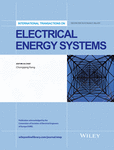Robust coordinated control for damping low frequency oscillations in high wind penetration power system
Abstract
The preeminence of wind power as a source of clean power generation is growing very fast. The increasing wind penetration, however, escalates the problem of low-frequency oscillations (LFOs) in the modern grid. In this paper, LFOs damping improvement is presented for a high wind penetration power system by a robust coordinated control strategy of the power system stabilizer (PSS) and power oscillation damper (POD) of doubly fed induction generator (DFIG). This control strategy is achieved using an improved eigenvalue-based objective function, optimized using grey wolf optimizer (GWO). The impact of wind farm location on system oscillatory stability is accomplished using eigenvalue analysis and dynamic sensitivity analysis. The wide-area-based phasor measurement unit (PMU) signals are used as PODs input selected using modal observability criterion. The eigenvalue analysis, time-domain simulations, and robustness analysis are performed to verify the efficacy of the proposed control strategy on a modified IEEE New England test system. The simulation results show the improvement in LFO damping with the proposed control strategy for a wide range of operating scenarios including faults and line outages at different loading conditions.




